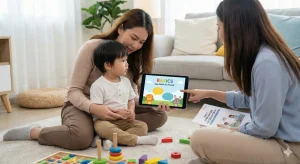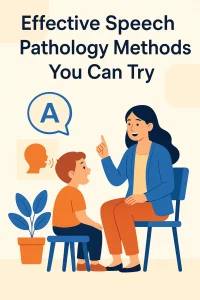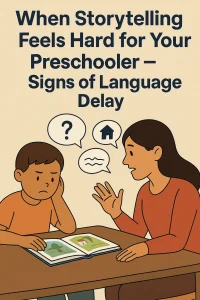Improve Your Speech – S Sentences for Speech Therapy
Last Updated: October 30, 2024
Struggling with the “S” sound, either personally or noticing it in your child?
Perfecting this often tricky sound is a common challenge, but it’s one that can be improved with focused practice. This guide introduces “S sentences”—fun, effective phrases designed to emphasize and refine the “S” sound. These targeted sentences are great for parents, speech therapists, or anyone aiming to boost clarity in speech. Dive in and discover how these exercises can help you or your child speak more confidently and clearly, bringing an exciting new level of precision to everyday conversations.
Why Focus on S Sentences?
In speech therapy, one of the keys to clear communication lies in articulation—producing sounds accurately and consistently. When articulation improves, speech clarity follows, making interactions smoother and reducing misunderstandings. Among the range of sounds targeted in speech therapy, the “S” sound often takes center stage. Why? It requires precise tongue placement and controlled airflow, which can make it uniquely challenging for many, especially children.
For example, a child might say “thun” instead of “sun” or replace “sand” with “shand.” These substitutions can make communication unclear and may lead to misunderstandings in everyday interactions. The causes of such difficulties often include incorrect tongue positioning, weaker oral muscles, or ingrained speech habits. But with consistent practice using S Sentences in speech therapy, these challenges can be overcome.
Practicing sentences that emphasize the “S” sound helps in multiple ways:
1. Contextual Learning
Working with sentences instead of isolated words helps learners naturally integrate the “S” sound into everyday language. For instance, consider the sentence, “Sara saw seven snails.” Practicing this sentence encourages the speaker to use the “S” sound in a way that mirrors real-life conversations, preparing them for practical, day-to-day speech.
2. Rhythm and Flow
Sentences bring in the natural rhythm of speech, helping learners practice not just sounds, but the flow and cadence of sentences. Imagine a sentence like “Sam’s sister sells seashells.” Practicing this builds an awareness of rhythm, allowing learners to keep a steady pace and maintain clarity even in fast or complex sentences.
3. Repetition and Reinforcement
By practicing “S” sentences consistently, the sound becomes second nature. Repeated sentences, such as “I saw the sunset by the seaside,” reinforce the correct tongue position and airflow, helping individuals achieve a confident, natural “S” sound in regular speech.
Also Read: Help Child Master /s/ Sound: Fun Activities & Pro Tips
Tips for Practicing S Sentences
Practicing “S” sentences effectively requires a mix of consistency, creativity, and support. Whether you’re a therapist guiding clients, a parent helping your child, or an adult working on your own speech goals, these tips will help you make the most out of every practice session.
1. Daily Practice
Consistency is essential for successful speech therapy. Setting aside even five minutes a day to practice “S” sentences can create a strong foundation for improvement. Just as brushing your teeth or exercising is a daily habit, making speech practice a regular part of the day leads to lasting progress. Try starting with short sentences like “Sam saw seven stars,” and gradually increase complexity as confidence builds. Daily commitment to these simple sessions makes a noticeable difference over time.
2. Interactive Methods
Turning practice into play can make speech exercises feel fun and enjoyable. Here are some interactive ideas that therapists and parents can try:
- Games: Incorporate speech practice into board games like Go Fish, Connect Four, or Jenga. For instance, before taking a turn, the child can say an “S” sentence like “Sally sells sea shells.” This keeps the focus on articulation while creating a fun, low-pressure environment for practicing the sound.
- Stories: Encourage storytelling with an “S” theme, or pick out books with frequent “S” sounds. For example, a parent could say, “Let’s make up a story about a silly squirrel,” where each sentence starts with or includes an “S” word. Reading these stories aloud not only enhances the “S” sound but also strengthens language skills and adds a natural flow to speech.
- Daily Conversations: Integrate “S” sentences into daily interactions. For example, say, “Let’s sit on the sofa and read a story,” or “The sun is shining brightly today.” Using these sentences in casual conversations makes practice part of the day’s rhythm, helping the learner become more comfortable with the “S” sound in real-life scenarios.
3. Home Practice
Parents and caregivers play a powerful role in reinforcing speech therapy at home. Here’s how you can help make the practice effective and enjoyable:
- Be Involved: Actively participate in each session, offering encouragement and guidance as needed. For example, join in with sentences like, “Sally’s silly smile” or, “The soft sand feels smooth,” so your child feels supported and motivated.
- Create a Routine: Establish a dedicated time each day for practicing “S” sentences, such as after breakfast or before bedtime. Consistent routines are incredibly helpful in forming lasting habits and ensuring regular practice.
- Positive Reinforcement: Celebrate every small achievement. Offering praise like, “Wow, you said that so clearly!” encourages ongoing effort and boosts self-confidence. Positive feedback helps transform speech practice into a rewarding experience, motivating learners to keep improving.
Effective S Sentences for Practice
To make progress in speech therapy, practicing specific sentences that focus on the “S” sound can be incredibly effective. Here are some simple and practical sentences you can use to enhance your articulation skills. These sentences include the “S” sound at the beginning, middle, and end, making them versatile for comprehensive practice.
1. Beginning of the Sentence
Starting with sentences that begin with the “S” sound helps learners focus on creating a strong initial sound, setting the tone for clear speech. Here are a few examples:
- “The sun sets over the sea.” – This sentence encourages a smooth “S” sound right at the start, helpful for those working on initial articulation.
- “Sarah sells seashells by the seashore.” – A fun tongue twister that keeps practice engaging while challenging clarity and flow.
- “The silver spoon sparkled in the sunlight.” – Ideal for building accuracy in sound production and sustaining the “S” sound through multiple words.
Case Scenario for Parents/Therapists: Start each session by saying these sentences together, emphasizing the “S” sound. For example, say, “Let’s both say ‘Sarah sells seashells by the seashore’ slowly and clearly.” Practicing together can make the exercise feel more collaborative and less intimidating for learners.
2. Middle of the Sentence
Practicing sentences with the “S” sound in the middle helps develop sound control within phrases, strengthening articulation in various contexts:
- “The castle stood tall against the sky.” – Perfect for children learning to manage the “S” sound within a sentence naturally.
- “We visited a massive museum last Sunday.” – This sentence supports building accuracy without losing the “S” sound in the middle of words.
- “He enjoys listening to classical music.” – Helps learners maintain the “S” sound even in longer words, building confidence in fluid speech.
Case Scenario for Parents/Therapists: Encourage children to create short stories using these sentences. For example, you could ask, “Can you think of a story about a castle and a sunny day?” This exercise reinforces “S” sound practice while boosting creativity and making the activity more interactive.
3. End of the Sentence
Using sentences that end with the “S” sound is especially helpful for practicing clear enunciation through to the last word, ensuring clarity throughout the sentence:
- “She rides the bus to school.” – A simple sentence for practicing “S” sounds at the end, helpful for children mastering full articulation.
- “Please pass the salt.” – Encourages crisp enunciation, especially in social situations where clarity is essential.
- “The class ends at three o’clock.” – A useful phrase for reinforcing final sound clarity, making speech more polished.
Case Scenario for Parents/Therapists: Try incorporating these sentences into daily routines. For instance, when passing the salt at the dinner table, say together, “Please pass the salt.” This natural approach integrates practice into daily life, reinforcing the “S” sound in an organic, memorable way.
How to Use These Sentences
Using these sentences naturally in daily conversations helps reinforce correct pronunciation. Try simple phrases like, “The sun sets over the sea,” while talking with friends or family. Casual use of these sentences during everyday interactions allows learners to practice without feeling like it’s a formal session, making a improvement natural part of their speech.
Case Example: During a family dinner, ask a child, “Do you think the sun is setting now?” or prompt them to describe their day using “S” sounds. For adults, casually including “S” sentences when speaking with colleagues or friends keeps practice consistent.
1. Reading Aloud
Reading these sentences out loud a few times each day helps build fluency with the “S” sound. Focus on proper articulation with each repetition, paying close attention to tongue placement and airflow. This not only strengthens the “S” sound but also builds overall speech confidence.
Case Example: A parent could have their child read sentences like, “Sarah sells seashells by the seashore,” while encouraging slow, clear pronunciation. Therapists may ask clients to read a few “S” sentences at the start or end of each session as a warm-up or wrap-up activity.
2. Games and Activities
Incorporating “S” sentences into games makes practice fun and engaging. Use games like Go Fish, Connect Four, or storytelling exercises to bring a playful element to speech practice. For instance, you could integrate “S” sentences into a simple role-playing game where participants use sentences such as, “Can I see the shiny silver shoes?”
Know more: Help Your Child Master /S/ Blends: Fun Speech Therapy Tips!
Case Example: Write “S” sentences on Jenga blocks; each player reads one aloud before pulling a block. For storytelling, prompt your child to make up a story using phrases like, “Seven swans swam silently.” These activities keep the focus on articulation while creating a light-hearted environment for practice.
Effective S Sentences for Different Positions
| Sentence Position | Example Sentences |
|---|---|
| Beginning | – The sun sets over the sea. – Sarah sells seashells by the seashore. – The silver spoon sparkled in the sunlight. – Seven swans swam silently. – Samantha’s sister sings softly. |
| Middle | – The castle stood tall against the sky. – We visited a massive museum last Sunday. – The whistle blew loudly at noon. – He enjoys listening to classical music. – The story was so fascinating that I couldn’t put it down. |
| End | – She rides the bus to school. – The grass needs to be cut. – Please pass the salt. – The class ends at three o’clock. – He likes to eat carrots. |
Techniques to Enhance S Sound Production
Improving the “S” sound in speech therapy involves multiple techniques to enhance learning. Here are a few effective methods:
1. Minimal Pairs Practice
Minimal pairs are pairs of words that differ by only one sound, such as the initial “S” sound. Practicing with these pairs helps learners distinguish and correctly produce the target sound. Examples include:
- Sea vs. Bee: “I saw the sea.” / “I saw a bee.”
- Sue vs. Zoo: “Sue likes ice cream.” / “The zoo has lions.”
Case Example: Have learners repeat each pair back-to-back, emphasizing the differences. This technique builds awareness of sound distinctions, which is particularly helpful for children and beginners.

2. Correct Tongue Placement
Proper tongue positioning is essential for producing a clear “S” sound. Here’s a step-by-step guide:
- Tip of the Tongue: Lightly place the tip of your tongue on the ridge just behind your upper front teeth.
- Sides of the Tongue: Press the sides of your tongue against your upper side teeth, allowing air to pass down the center.
- Airflow: Smile and blow a narrow stream of air over the center of your tongue, ensuring it doesn’t escape from the sides.
Case Example: Use a mirror for visual feedback, watching the tongue position and airflow. Practicing this placement with minimal pairs or “S” sentences makes it easier to produce the sound correctly in regular conversation.
3. Use of Visual Aids
Visual aids can be highly effective for mastering the “S” sound. Here are some helpful options:
- Mirrors: Practice in front of a mirror to see tongue and mouth position, helping make adjustments in real-time.
- Apps: Some speech therapy apps offer visual feedback and animations to assist with tongue placement and airflow control.
Case Example: A therapist might encourage clients to use a mirror during home practice, reinforcing what they’ve learned in sessions.
Minimal Pairs for S Sound
| Word Pair | Example Sentences |
|---|---|
| Sea vs. Bee | I saw the sea. I saw a bee. |
| Sue vs. Zoo | Sue likes ice cream. The zoo has lions. |
| Sip vs. Zip | Take a sip of water. Zip up your jacket. |
| Sing vs. Ring | Sing a song. Wear a ring. |
| Seal vs. Zeal | He is a seal trainer. She showed great zeal. |
| So vs. Zoo | So, what do you think? The zoo is fun. |
| Sink vs. Zinc | The ship will sink. Zinc is a metal. |
| Saw vs. Raw | I saw a bird. The meat is raw. |
Learn more: Mastering Bilabial Sounds in Children: A Parent’s Guide
Fun Activities to Make Practice Enjoyable
Making speech therapy enjoyable boosts motivation and effectiveness. Here are some fun ways to incorporate “S” sentences:
1. Board Games
Board games can turn learning into an enjoyable activity. Here’s how:
- Go Fish: Create custom cards with “S” sentences. Players read a sentence before asking for a card.
- Jenga: Write “S” sentences on blocks. Players read the sentence before removing a block.
Case Example: Playing these games during family time makes speech practice feel less formal and more enjoyable, especially for children.
2. Storytelling
Encourage creativity by using “S” sentences in storytelling:
- Story Creation: Have children create a story using “S” sentences, like “Seven snails slept silently.”
- Reading Aloud: Select books or stories filled with “S” sounds for reading practice.
Case Example: Therapists might ask clients to make up short stories incorporating the “S” sound. This adds a creative element to practice while strengthening articulation.
Know more: Boost Kids Storytelling Skills: Engage and Educate at Home
3. Role-Playing
Role-playing scenarios add a practical, everyday context for using the “S” sound:
- Shopkeeper and Customer: One person is the shopkeeper, and the other is the customer. Use sentences like, “I’d like some socks.”
- Doctor and Patient: Pretend to be a doctor and patient using sentences like, “My stomach is sore.”
Case Example: Role-playing with a parent or therapist helps learners feel more comfortable using the “S” sound in realistic situations.
Conclusion
Practicing “S” sentences is a powerful way to improve speech clarity and build confidence. By using these tips daily, incorporating games, and adding fun activities, learners can make real progress with the “S” sound. Remember, regular practice is key—just a few minutes each day can make a big difference! Whether you’re a parent, therapist, or someone working on personal goals, try integrating these techniques into your routine for lasting results.
Frequently Asked Questions:
1. What are the best S sentences for speech therapy?
The best S sentences for speech therapy are simple, clear, and repetitive. Examples include: “The sun sets over the Sea,” “Sarah sells seashells by the Seashore,” and “Singing Songs is So much Fun.”
2. How can S sentences improve speech therapy results?
Practicing S sentences helps improve articulation by providing consistent practice with the S sound in different contexts. This helps individuals get better at producing the sound correctly in everyday speech.
3. Why use S sentences in speech therapy?
S sentences are used in speech therapy because they help target the specific S sound, making it easier for individuals to focus on and improve their articulation. Practicing sentences rather than isolated words helps integrate the sound into natural speech.
4. Which S sentences are effective for speech therapy?
Effective S sentences for speech therapy include: “The silver spoon sparkled in the sunlight,” “Seven swans swam silently,” and “Please pass the salt.” These sentences provide varied practice with the S sound at the beginning, middle, and end of words.
5. How to practice S sentences for better speech therapy results?
To practice S sentences for better results, incorporate them into daily routines. Use fun activities like board games, storytelling, and role-playing. Consistent daily practice, even for a few minutes, can significantly improve speech clarity.
6. What techniques can enhance S sound production?
Techniques to enhance S sound production include practicing minimal pairs (e.g., “sea” vs. “bee”), ensuring correct tongue placement, and using visual aids like mirrors or apps to check and correct sound production.
7. How often should S sentences be practiced?
S sentences should be practiced daily. Consistent, short practice sessions of about 5-10 minutes each day can lead to significant improvements over time.
8. What are some fun ways to practice S sentences?
Fun ways to practice S sentences include playing board games like Go Fish and Connect Four, creating stories with lots of S sounds, and role-playing scenarios such as shopkeeper and customer or doctor and patient.
9. Can adults benefit from practicing S sentences?
Yes, adults can benefit from practicing S sentences. Improving articulation and speech clarity is beneficial for both personal and professional communication.
10. How do minimal pairs help in S sound practice?
Minimal pairs are pairs of words that differ by only one sound, such as “sea” and “bee.” Practicing minimal pairs helps individuals distinguish and correctly produce the S sound by highlighting the differences between similar sounds.
About the Author:
Anuradha Karanam
Speech-language pathologist (7+ years of experience)
Anuradha Karanam is a skilled speech-language pathologist with over 6 years of experience. Fluent in Tamil, Telugu, Hindi, and English, she specializes in parent counseling, speech sound disorders, fluency assessment, and speech-language evaluations. Anuradha excels at working with children with developmental disorders, offering creative and effective therapy programs. Currently, at Wellness Hub, she holds a BASLP degree and is registered with the RCI (CRR No A85500). Her patience, ambition, and dedication make her a trusted expert.
Book your Free Consultation Today
Parent/Caregiver Info:
Client’s Details:
* Error Message









